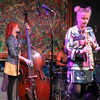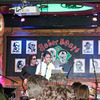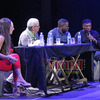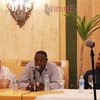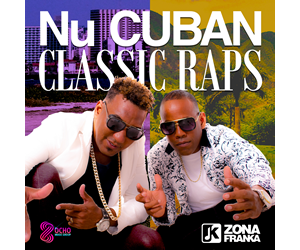Indice - Table of contents
New Stuff[hide]
Reportes: From The St... : Jazz Plaza ...
Fotos: Tom Ehrlich : Irakere 50th Annivers...
Fotos: Tom Ehrlich : Irakere
Resenas: Joey Altruda Presents: El Gran ...
Reportes: From The St... : Cubadisco 2...
Timbapedia: 09. Interviews -... : Carlos del Pino ...
Fotos: Tom Ehrlich : 2023 Monterey Jazz Fe...
Fotos: Tom Ehrlich : 2023 Monterey Jazz Fe...
Fotos: Tom Ehrlich : 2023 Monterey Jazz Fe...
Fotos: Tom Ehrlich : 2023 Monterey Jazz Fe...
Grupos: Tirso Duarte
Grupos: Tirso Duarte : Discography
Grupos: Charanga Habaner... : 8. El bla bla bla
Grupos: Pupy y los que S... : Tirso Duarte
Photos of the Day [hide]
SpanishEnglishClave Changes Track by Track - Extraños ateos
2) "Extraños Ateos" - We've explained how to analyze the clave direction of each percussion instrument and how to identify the various types of clave changes, but all of this assumes that the non-percussion instruments are making it crystal clear where the musical phrases begin. Clave is a circular pattern which really has no beginning or ending; it's only the melody and harmony which make us feel that the phrase is beginning on the "2" or "3" side. If a "Clave License" change occurs, we can say for certain that the clave has changed and it would be obvious even without the non-percussion instruments, because you would hear the 2 or 3 side twice in a row. In fact, a "Clave License" change would be even more obvious without the non-percussion instruments, but in the case of a continuous, or "New York style" clave change, the clave has only changed if the musical context convinces us that it has. It would be possible for one musician to be "hearing" the clave as 2:3 and another as 3:2. As long as the percussion instruments are locked together and cycling the clave continuously, where the phrase begins and ends is in the ear of the beholder.
Some of La Charanga's most inspired moments of musical genius juxtapose multiple musical ideas which can actually appear to begin on different sides of the clave, creating whole passages which can be heard in 3:2 or 2:3 depending on which part one is hearing as being the dominant one. Of course, each musician is himself feeling it one way or the other and in the case of a band that rehearses as much as CH, it's almost certain that they're all feeling it the same way. But even when one is lucky enough to have the opportunity to ask one of the players, semantic problems can lead to an ambiguous reply, bringing to mind the 11th Commandment, which is frequently even more tempting to disobey than the other ten: "Never ask a Cuban about clave". With that ominous warning we proceed to one most glorious arrangements in the history of Timba: "Extraños Ateos". It starts out innocently enough in first gear, 2:3 clave, with the jamblock playing clave. When the horns come in by themselves at 1:06 we are suddenly in 3:2. It's definitely "clave license style" but where did it actually change? Go back to about 0:47 [audio example 23] and focus on the 2:3 jamblock. The clave-ambiguity begins at 1:01. The jamblock is still playing, but it's not playing clave. It plays: (0:58) By the 4th bar, we’re clearly in 3:2, but on the second bar Sombrilla sings a phrase which is later repeated many times in 3:2 clave: "solo se acuerdan Deos cuando truena". So we'd say that a 3:3 Clave License change occurs right at 1:01 although the next sure-fire clave indicator doesn't come until the fourth bar shown, at 1:08, when the jamblock starts stating clave literally again. [2006 addition: The ambiguity actually ends at the beginning of the 4th bar because the opening horn rhythm, 0||x0x0x|x00x, is unequivocally a 3-side phrase]. Try playing 2:3 clave from the beginning and on the last 3 side before "sólo se acuerdan...", at 1:01, leave off the last note of the three side and start the 3 side over immediately on the next bar. You could also do this on the next clave instead. Regardless, the clave has changed, clave license style, and we're now in 3:2, a rare case of first gear in 3:2 clave, which lasts only until the bloque at 1:23. After this we go into 3rd gear, still in 3:2. This change is much harder to decipher than anything on the other 7 songs on the album, but the ultimate answer is conclusive. The next few sections are the among the most difficult, ambiguous, and most exhilarating in the entire output of Charanga Habanera! At 2:07, what we call the "Love Potion #9 mambo" comes in, in 3:2, or is it? There’s a curious figure in the campana. Here’s what the open tone of the campana plays from the very beginning of the horn entrance: 0xxx|0xxx|0xxx|0xxx This is a puzzlement, as the usually trustworthy 2nd gear campana plays its telltale 3 side figure on both sides, and the figure at the end of the 2nd, 6th and 8th bars is one that’s often used on the 3 side. But the music before and after this section is consistent with the section being in 3:2. The maracas and güiro, as always, are clave-neutral and almost completely mask the timbales in the mix, but right at the beginning of the example you can hear a trace of the 3:2 contracampana pattern, and the congas briefly imply the three side with the big drum. Finally, the vocal section eventually repeats the earlier "sólo te acuerdas deos cuando truena", and so we conclude that this section is in 3:2. If this were a Fanis All-Stars track, and thus governed by the continuous clave rule, this section would have to be in 3:2 because the section before it is was, but when Clave License is at play, you can never be too sure! In the following section, starting at 2:40, the opposite problem occurs! [audio example 25] There’s no doubt whatsoever where the clave is, but where the phrase starts is profoundly ambiguous! This is also, and perhaps not coincidentally, one of the most inspired passages of music in all of CH’s albums, and all of Timba for that matter. It’s very possible to hear the phrase as starting in 2:3 or 3:2 and it sounds wonderful either way. It’s as if the piano and bass are having a tug-of-war with the coro and metales. Let’s start by hearing it in 2:3. [audio example 26] is a MIDI recording with a 4 beat countoff after which the piano piano tumbao and clave enter in 2:3. Presented this way, the listener is being strongly influenced to hear the section in 2:3. If the section really is in 2:3, then we have a New York style clave change at right at 2:40.. The piano’s entrance marks the beginning of a 2:3 phrase with a chord progression which is roughly IV - V - V - I (bVII). (It’s actually a contrapuntal harmony based on 10ths). Listen to the MIDI example until it feels right in 2:3. In this 2:3 scenario "tú te acuerdas de" is the pickup and the 2:3 phrase begins with "Santa Bárbara, sólo cuando truena", and likewise the answer from the horns also begins with pickups. The bloque at 3:02, the piano glisando and the entrance of the bass all strongly reinforce the idea that this whole section is in 2:3 and Sombrilla’s guías sound fantastic when listening from the 2:3 perspective as well. If you’re listening as if the section is in 2:3, you'll then hear a rather abrupt NY style change back to 3:2 when the "Love Potion #9" mambo returns at 3:35. But now try listening from the 3:2 perspective. [audio example 27] gives you the countoff and then starts the piano piano tumbao on the three side. Focus on the coro. Now the chord progression becomes I (bVII) - IV - V - V, a somewhat more common chord progression than IV - V - V- I (bVII). When you've learned to hear the piano tumbao this way, listen to the real audio again [audio example 25]. Think of the piano entrance as a pickup bar and think of "tú te acuerdas" not as the pickup, but as the beginning of the phrase, with "tú" being the downbeat of 1. Everything still makes sense and now there’s no clave change going in or out of this section. Go back to 2:30 (if you have the CD) and start clapping 3:2 at "sabes que problemas vendrán" -- you can stay in 3:2 all the way through the section. So it can work as 2:3 or 3:2, and in some very strange sense, it can actually work both ways at once, with the piano pulling you towards 2:3 and the coro towards 3:2. Perhaps this is part of the magic of the section, which never seems to grow old, even with hundreds of listenings. But we’re nowhere near out of the woods on this one yet! At 3:58 we get a clear clave change - 3:3 Clave License style. [audio example 28]. The unaccompanied piano entrance has to be one the 3 side. Start clapping 3:2 at 3:54 with "solo te acuerdas". Clap 3:2:3, but leave off the last note of the final 3 side and the start over with 3:2. This is another whole section which can be heard with the phrase beginning on the 2 or 3 side. The coro, "tú te acuerda de — sólo cuando true…" is a skeletonization of the previous coro, so it makes sense to think of it in the same way you thought of it the first time. The next coro, "el aché que Changó me dió, nadie me lo quita", at 4:35, is clearly 3:2, so if you’re in 2:3 perspective, it’s a NY style clave change, but if you’re in 3:2 perspective, it flows right through. The beauty of the 3:2 perspective is that it greatly reduces the number of clave changes. Clave License style changes are absolute and occur no matter what mental perspective you use to listen to the song, but by hearing the coros of this song in 3:2, many of the NY style changes disappear. Nevertheless, some of the sections groove like there’s no tomorrow when you listen to them from the 2:3 perspective! In any case, at 4:34 we’re clearly in 3:2. At 4:39 the genius of this arrangement becomes absolutely indisputable! Before the "el aché que Changó me dió" coro ends, another overlapping coro begins, "Jorobita, Jorobita, lo que se da no se quita". Both are clearly in 3:2, but listen to the piano roar in on the 2 side beneath the second "Jorobita". The arrangement concludes with a rapid-fire recap of many the previous ideas, treated consistently in respect to the clave. The "Love Potion #9" mambo returns briefly at 5:30 and dovetails into the same amazing bloque which occurred at 1:21, then a false ending, another piano entrance on the 2 side and finally a fade on the overlapping 3:2 coros from 4:39.
xx0x|0xxx|0xx0|xxx0
xx0x|x0xx|0xxx|xxxx
xxxx|xxxx|xxxx|xxxx
xxxx|xxxx|xx0x|0xxx
0xx0|xxx0|xx0x|0xxx
0xxx|0xxx|0x0x|xx0x
xxxx|xxxx|0xx0|xxxx
0xx0|xxxx|0xx0|xxxx
xxxx|xxxx|0xxx|0xxx
0xxx|0xxx|0x0x|xx0x
xxxx|xxxx|0xx0|xxxx
0xx0|xxxx|0x0x|xx0x
In summary, the simplest way to listen to this song is to call the opening minute 2:3 and then doggedly hear the rest in 3:2, changing clave in 3:3 clave license style at 3:58, but even after you learn to hear it this way, it’s still clear that many piano, bass and percussion entrances are designed to feel like 2:3, such as the one at 5:17. "Extraños Ateos" is almost undoubtedly the hardest arrangment on any of the CH albums from a clave perspective, but it's well worth the time and effort.










